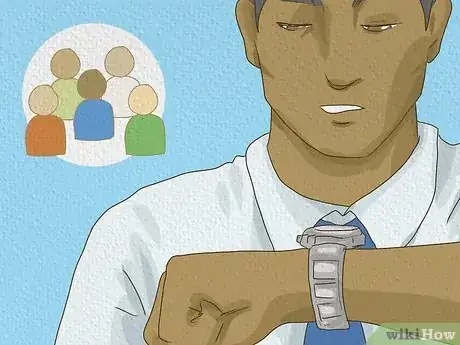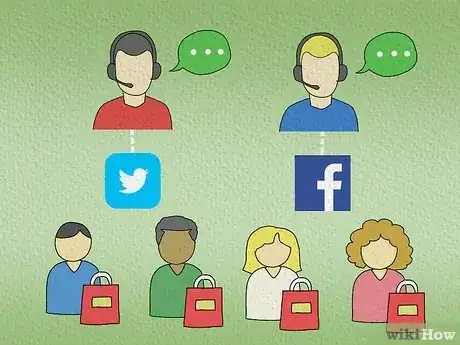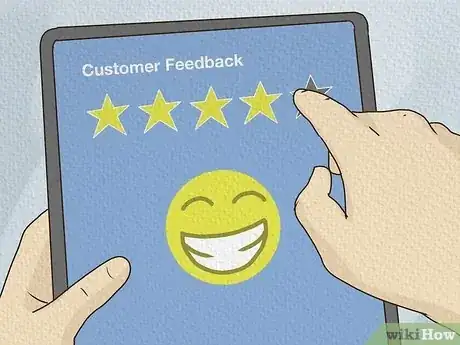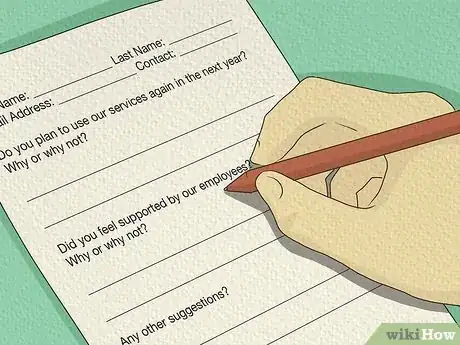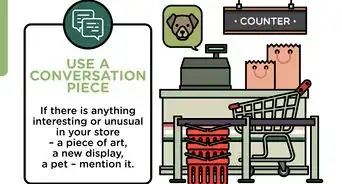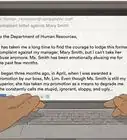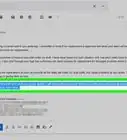This article was co-authored by Michael R. Lewis. Michael R. Lewis is a retired corporate executive, entrepreneur, and investment advisor in Texas. He has over 40 years of experience in business and finance, including as a Vice President for Blue Cross Blue Shield of Texas. He has a BBA in Industrial Management from the University of Texas at Austin.
There are 16 references cited in this article, which can be found at the bottom of the page.
This article has been viewed 68,601 times.
When you deal directly with customers, it's really important to leave them with a good impression so they feel like they're valuable to your company. Luckily, we can show you how to create a customer service experience that will leave the majority of people satisfied!
Steps
Designing a Customer-Friendly Experience
-
1Please your customer the first time around. Though many people think that customer service is just about handling complaints, it is even more important to keep your customer from becoming unhappy in the first place. It is much more difficult to make someone happy after they have been disappointed.[1] Design your customer experience in such a way as to prevent customer unhappiness.
-
2Define your ideal customer. It would be time-consuming and costly to tailor your customer experience to every single unique individual.[2] Instead, think carefully about who your ideal, typical customer is. Design your policies with your ideal customer in mind.[3] Ask yourself:Advertisement
-
3Exceed customer expectations. Rather than giving them the bare minimum, make your customers especially happy by meeting and then exceeding their needs.[6] This will impress your customer and encourage them to remain loyal to your company. Trying to exceed customer expectations will build goodwill and may give you the opportunity to correct any deficit before it becomes a significant problem.
- For example, if your ideal customer will require a service within 10 hours, try to make sure that you provide it to them within 8 hours.
-
4Design your business space with your customer in mind. Your office or store should be a comfortable, clean, welcoming environment for your customer. Your office must also be laid out in a sensible and logical way that will be easy for your customer to navigate. Consider things such as:
- Having parking spaces designated for your customers only.
- Making sure your offices are accessible to customers with disabilities and injuries.
- Hanging up effective signage to direct your customers where they need to go.
- Placing directories, informational brochures, or store maps at key locations such as entrances and stairwells.
- Stationing a staff member near entryways to direct customers as needed.
-
5Give individual attention to customers to make them feel special. Customers respond well to individualized attention. Make sure that the philosophy of your company places the customer first and treats them like people instead of numbers. For example, customers appreciate it when you:
- Introduce yourself by name.
- Ask your customer's name.
- Spend a few minutes listening to their specific needs.
- Assist them with what they have requested: do not simply launch into a generic, memorize spiel.
-
6Double-check customer service in your office. Put yourself in the shoes of your customers or clients. Then test out the customer experience at your business to determine whether any other improvements can be made. Some ways that you can test the user experience include:
- Calling the office to make sure the phone system is easy to navigate.
- Sending a test email to see how long it takes to get a response.
- Walking through your store to check that items are clearly labeled, logically arranged, and fully stocked so that customers find the products they seek.
- Using your company's live chat feature to see how quickly a complaint can be resolved.
-
7Provide your customers with self-service options. Self-service options such as self-checkout lines in shops, service forums with troubleshooting hints, and automated services can help you meet your customers' needs more efficiently. Many customers like having these options, since they can be used at any time of day, including during non-business hours. Customers are especially happy with self-service options when they run smoothly and logically.
- Many customers get frustrated by poorly functioning self-service stations, however.[7] Make sure that you have clear instructions on how to use self-service options, and you should consider stationing an employee nearby to troubleshoot if possible.
-
8Know when your busy times are. Keep tabs on when you are likely to have a rush of customers and when business is more likely to be slow. Make sure you have enough customer support available during crunch times.[8] Depending on your business, you might be especially busy during the holidays, over the lunch hour, or during evenings and weekends. Your customers will be happiest if you have enough staff to take care of them during these busy times.
-
9Ensure your prices are competitive and consistent with your targeted customers' expectations. Make sure that the price on your goods and services is a fair one that is in line with your competitors' pricing. Effective sales, loyalty discounts, and clearance sections are some good ways to make your customers feel like they are being rewarded for their loyalty. In all cases, make sure that your prices are clearly labeled to avoid frustrating your customers.
- Keep in mind that people associate price with quality, so if your target customer is up-scale and looking for convenience, price is less of a factor and you may be able to charge a little more.
- Be careful that you are not under-pricing your goods and services so that you lose money. Don't bankrupt your company for the sake of customer satisfaction.[9]
Training Your Customer Service Team
-
1Develop performance metrics to measure customer service. It is essential to establish the metrics you want staff to meet because if you can't measure it, you cannot manage it. What defines good customer service at your company? Is it repeat visits? Average check-out times? Number of items per ticket? Quick response time to complaints? Problem resolution time? Once you have established this list and how to track your metrics, communicate this to your employees.
- If one of your metrics is items per ticket, track the basket size of your customers on a weekly basis. You can find out the average number of items per ticket, then figure out ways to grow that number. Maybe you need to educate your employees on all of your products so they can encourage customers to add a few more products to their baskets. Or perhaps the shelves are not restocked often enough, so people can't buy all of the items they need. Increasing ticket size may require you to hire more people to keep the shelves stocked or prioritize restocking right before the busiest times of the day.
-
2Institute policies that make it easy to treat customers well. You should provide your customer service representatives and employees with the proper guidelines for keeping customers happy. These might include proper greetings, procedures for dealing with unhappy customers, or guidelines about how long customers should be kept on hold.[10] Make sure that these procedures are clearly laid out for your staff and that they are possible to implement. Consider providing them with a booklet or handouts to help them remember their customer service policies.
-
3Be conscious of cultural differences. Your customer might have different thoughts and ideas than you because of their cultural background. Make sure your employees are trained in handling encounters with people from other cultures to reduce the chances of cross-cultural misunderstandings.
-
4Keep your promises. Never break a promise you make to a customer.[11] Only promise them what you can actually provide, and then provide them with that service.
- For example, do not promise a customer a refund unless you are absolutely sure that a refund can be granted to him. And do not promise a customer that you can get her a 30% discount when she only qualifies for a 15% discount.
-
5Give your customer service representatives leeway in dealing with problems.[12] Even though effective company policies are important tools to keep customers happy, you also have to trust your team of employees. There are some situations that a company policy does not cover, and sometimes decisions have to be made on the fly. Allow your employees some reasonable leeway in how they deal with customer grievances or unexpected situations.
- For example, your customer service representative might give an angry customer three extra coupons even if company policy is to provide just one coupon. Rather than getting angry at your employee, trust that her judgment provided the smoothest resolution to the problem.
- At the same time, it is important to educate your employees so they know just how much leeway they have to satisfy a complaint, and when they should turn a complaint over to a supervisor. Providing your employees with written rules and policies can help make this clear.
-
6Reward employees who go above and beyond in their customer service. If your employees get rewarded for treating customers well, they will see just how important excellent customer service is to your organization.[13] Consider creating a monthly award in your office for the star customer service provider. You might also provide bonuses to the service teams that help improve customer loyalty.
- By establishing your metrics early on, you can use tangible results to reward your employees. If you have comment cards or a customer satisfaction survey, you can reward the person who scores the highest. Or if you can track how quickly customer service problems are resolved, you can reward the employee with the fastest and most accurate problem resolution time.
-
7Train staff to communicate effectively. Emphasize to your employees that good posture, a clear speaking voice, a friendly demeanor, and a professional appearance are all essential to good customer service.[14] First impressions are important in communicating with customers. Ask your staff members to enunciate especially clearly and slowly if they deal with customers on the phone.
-
8Schedule customer service trainings with your staff. There are a number of methods you could use to help teach your employees necessary customer service skills. For example, you could use role-playing exercises to practice customer service, hire coaches to run workshops, or ask your employees to complete online training modules. Even a two-hour workshop might help your staff learn new tricks for making customers feel taken care of.
Communicating with Customers
-
1Adhere to good phone etiquette. Phone etiquette involves promptness, clarity, and enthusiasm for meeting the customer's needs.[15] You want your customer to feel like he is being taken care of, even if he is in another city or state. Some important aspects of phone etiquette include:
- Making sure that all phones are answered within 3 rings if possible.
- Answering the phone in a friendly manner.
- Speaking slowly, clearly, and at an appropriate volume.
- Greeting your customer with your name and with the name/division of your company.
- Asking your customer how you can help them.
- Providing immediate assistance, whether that involves transferring the call to another person, beginning the process of refunding money, or answering a question about how to use a product.
- Being clear about what steps are being taken to meet the customer's needs.
- Being honest about what you can do for them. If you cannot answer their question immediately, ask if you can call them back once you have your answer.
-
2Avoid negative statements. Customers do not like being told "no" or "never." Instead of using negative language, try to use positive statements to affirm your desire to help your customers.[16] Be honest, but also emphasize how proactive you are in taking care of your customer.
- Instead of saying, "I don't know the answer to that question," tell your customer: "Let me find someone who can help you with this matter. Might I have them call you back in a few minutes?"
- Instead of saying, "This is not my job," tell your customer: "May I transfer you to another department? They can help you there."
- Instead of saying, "The company would never agree to that," tell your customer: "I'll do everything I can to make sure you are happy. I'm going to talk to my supervisor about what our options might be."
-
3Provide a call-back option instead of long hold times. Customers appreciate not being kept on the line for hours.[17] During those times when the phone is ringing off the hook, ask your customer if you can schedule a phone call for the near future. Have a customer service representative call your customer back at the designated time. This way, your customer will not become increasingly frustrated and will be able to go about his day.
-
4Respond to customer queries within 10 hours. Response time to customer questions is one of the central components of customer satisfaction (or dissatisfaction). Make sure you respond within 10 hours of any complaint or question.[18]
Optimizing the Online Experience
-
1Set up a great Frequently Asked Questions section on your website. Customers are happier when they have online resources to guide them through their user experience.[19] This will also free up your phone lines and email inboxes from unnecessary communications. You and your customer will save time with the help of a well-organized, thorough FAQs section. Your FAQs might address anything from how you conduct business to specific technical issues pertaining to a product you sell. Be sure that you write clear, concise, and jargon-free answers to each FAQ. The FAQs you choose will depend on the business you run, but some sample FAQs might include things like:
- What forms of identification do I need to bring in in order to purchase this product?
- What is the difference between the regular service plan and the premium service plan?
- Are there wholesale options for this product?
- How do I operate this software package on a PC?
-
2Create a seamless online and offline experience. Make sure that your online presence is as well-organized and inviting as your in-store experience.[20] Any important information that you would advertise in your store should also be clearly marked online.[21] Your hours of operation, contact information, address, and other details should be accurately posted on your company website. Be sure that there are no discrepancies between what you tell your customers in-person or over the phone and what you present on the internet.
-
3Create multi-channel customer support. Make sure you have a service presence online and in person, on Facebook and on Twitter. The more venues your company participates in, the more likely your customer will be able to find you and get her questions answered.[22] Have designated customer service representatives monitor your social media to make sure frustrated customers are provided with solutions.
- If you have the bandwidth and personnel, you can also monitor a service support forum online.[23] This will allow customers to help each other troubleshoot and will also give you important feedback on how you can improve.
-
4Provide a live-chat option. If possible, try to set up a system where customers can communicate with a representative through a live-chat.[24] This can save your customer and yourself time by avoiding email chains and lengthy voice-mails. Your customer will appreciate that you take just as much care of them online as you do in store.
Dealing with Customer Complaints
-
1Remember that complaints are useful. Do not look at complaints as annoyances. Complaints provide essential information to a business. They point out issues that might be bothering many, many other customers. Tell yourself that complaints are a free form of feedback to your company, and they will allow you to solve new problems.
-
2Communicate clearly to customers what the grievance procedure is. Do not hide this information in the fine print. Let customers know clearly and simply what they should do if they are unhappy with your service.[25] You should also take pains to ensure that the procedure is a simple one. Do not try to dissuade customers from returning items by making it a labyrinthine process: they might never return to your store.
-
3Use active-listening techniques. Make sure you listen carefully to your customers by using active listening techniques. Restate their concerns to make sure you understand them, maintain eye contact, nod at appropriate times, and avoid using jargon or skeptical language.[26] Make sure that any questions you ask are to get necessary information, not to "entrap" your customer in any way.
-
4Affirm the customer's frustration. An angered customer wants to feel supported by your company. Make sure that you apologize and explain that you understand just how frustrating the situation is.[27] This is an effective technique for defusing tension as well as beginning the process of making things right. You can tell an angry customer:
- "I can see why is is so frustrating for you."
- "I am sorry that you were put into such a frustrating situation."
- "I understand that you are angry. I will try to make this right."
-
5Provide customers with options. If a problem arises, consider giving your customer different choices about how things could be made right. If you provide several possible solutions and allow the customer to choose, your customer will feel like she has regained some control over a frustrating situation.[28] For example, you might say,
- "I am so sorry that you received a stained shirt in the mail. Would you like us to send you a new shirt, or would you like your money back?"
- "I apologize that our contractor did not arrive at your home at the appointed time. We are happy to provide you with a 20% discount for the services you ordered. Or, if you would prefer, we can give you the premium package for no added cost."
-
6Solve problems promptly. No matter what, make sure that the customer's questions and concerns are dealt with as soon as possible. Whether it is a store return, a future discount, scheduling a new meeting, or having a manager apologize, it is important to handle complaints in a timely fashion.[29]
-
7Say thank you. Thank your customers for using your products and services. Your gratitude can be expressed in person, through store signage, or with physical thank you notes that you personally send to your customers. Be appreciative for the presence of your customers: without them, your business would not thrive.
Getting Customer Feedback
-
1Implement a customer satisfaction survey. Many business leaders overestimate their company's ability to provide good customer service. Be honest with yourself about how happy your customers are with your services and products.[30] A customer satisfaction survey will allow you to get a more objective view of how well you are providing customer service.[31]
- Providing customers with a reward for filling out the survey will help encourage participation. For example, you might enter them in a raffle or provide them with a coupon for agreeing to fill out the form.
-
2Keep customer satisfaction surveys short. You don't want to include more than 10-15 questions in your survey.[32] You want the survey to be comprehensive but not a chore for your customers. Customer satisfaction survey questions can include things like:
- "Do you plan to use our services again in the next year? Why or why not?"
- "Did you feel supported by our employees? Why or why not?"
- "How easy is it to navigate our website? Please rank our website's user-friendliness on a scale of 1 to 10, with 1 being the least user-friendly and 10 being the most."
-
3Ask how you can improve customer service in the future. Use your customers as a resource for learning about new techniques for dealing with problems. You might also learn about how your competition might handle customer service issues.[33] You will be able to determine what your company is doing well and what policies might not be working as effectively as you'd like.
-
4Ask your customers about your competition. Perhaps your competitors have more effective customer service policies than you do. If this is the case, it is important that you know about it so that you can improve. Make sure that your customer satisfaction survey asks your customers how they feel about your competition.[34]
-
5Tell them why participating in your survey is important. Customers like feeling heard, and they will be happy to have some agency as they give feedback to your company. However, you should also emphasize the significance of their role as they fill out the survey. Let them know that their opinions will help future customers have an excellent customer service experience. Thank your customers for helping you meet their needs effectively.[35]
References
- ↑ http://www.customerservicemanager.com/15-principles-for-complete-customer-service/
- ↑ http://sloanreview.mit.edu/article/the-high-price-of-customer-satisfaction/
- ↑ http://www.geog.cam.ac.uk/research/projects/insectfarming/StaffCapacityBuilding.pdf
- ↑ http://www.geog.cam.ac.uk/research/projects/insectfarming/StaffCapacityBuilding.pdf
- ↑ http://sloanreview.mit.edu/article/understanding-your-customer-isnt-enough/
- ↑ http://www.customerservicemanager.com/15-principles-for-complete-customer-service/
- ↑ http://sloanreview.mit.edu/article/how-customers-view-self-service-technologies/
- ↑ http://www.cio.com/article/2891850/customer-relationship-management/11-tips-for-improving-your-company-s-customer-support.html?page=2
- ↑ http://sloanreview.mit.edu/article/the-high-price-of-customer-satisfaction/
- ↑ http://www.customerservicemanager.com/15-principles-for-complete-customer-service/
- ↑ http://www.babson.edu/offices-services/human-resources/employment/students/policies/Pages/student-employee-policies.aspx
- ↑ http://www.cio.com/article/2891850/customer-relationship-management/11-tips-for-improving-your-company-s-customer-support.html?page=2
- ↑ http://www.customerservicemanager.com/15-principles-for-complete-customer-service/
- ↑ http://www.geog.cam.ac.uk/research/projects/insectfarming/StaffCapacityBuilding.pdf
- ↑ http://www.geog.cam.ac.uk/research/projects/insectfarming/StaffCapacityBuilding.pdf
- ↑ http://www.geog.cam.ac.uk/research/projects/insectfarming/StaffCapacityBuilding.pdf
- ↑ http://www.cio.com/article/2891850/customer-relationship-management/11-tips-for-improving-your-company-s-customer-support.html?page=2
- ↑ http://www.forbes.com/sites/ciocentral/2012/04/19/customer-satisfaction-by-the-numbers-an-industry-breakdown/2/
- ↑ http://www.forbes.com/sites/ciocentral/2012/04/19/customer-satisfaction-by-the-numbers-an-industry-breakdown/2/
- ↑ http://sloanreview.mit.edu/article/how-to-drive-customer-satisfaction/
- ↑ http://www.forbes.com/sites/micahsolomon/2014/10/10/20-ultimate-tips-for-customer-service-week-2014/
- ↑ http://www.forbes.com/sites/ciocentral/2012/04/19/customer-satisfaction-by-the-numbers-an-industry-breakdown/2/
- ↑ http://www.forbes.com/sites/theyec/2013/01/09/5-easy-ways-to-gain-customer-feedback-on-your-product/
- ↑ http://www.cio.com/article/2891850/customer-relationship-management/11-tips-for-improving-your-company-s-customer-support.html
- ↑ http://www.forbes.com/sites/micahsolomon/2014/10/10/20-ultimate-tips-for-customer-service-week-2014/
- ↑ http://www.cio.com/article/2891850/customer-relationship-management/11-tips-for-improving-your-company-s-customer-support.html?page=2
- ↑ http://www.babson.edu/offices-services/human-resources/employment/students/policies/Pages/student-employee-policies.aspx
- ↑ http://www.babson.edu/offices-services/human-resources/employment/students/policies/Pages/student-employee-policies.aspx
- ↑ http://www.geog.cam.ac.uk/research/projects/insectfarming/StaffCapacityBuilding.pdf
- ↑ http://sloanreview.mit.edu/article/is-your-company-as-customer-focused-as-you-think/
- ↑ http://www.customerservicemanager.com/making-customer-satisfaction-surveys-work/
- ↑ http://www.forbes.com/sites/theyec/2013/01/09/5-easy-ways-to-gain-customer-feedback-on-your-product/
- ↑ https://journals.psu.edu/mentor/article/view/61308/60940
- ↑ http://sloanreview.mit.edu/article/the-high-price-of-customer-satisfaction/
- ↑ http://www.forbes.com/sites/theyec/2011/12/14/3-reasons-to-ask-for-customer-feedback/







